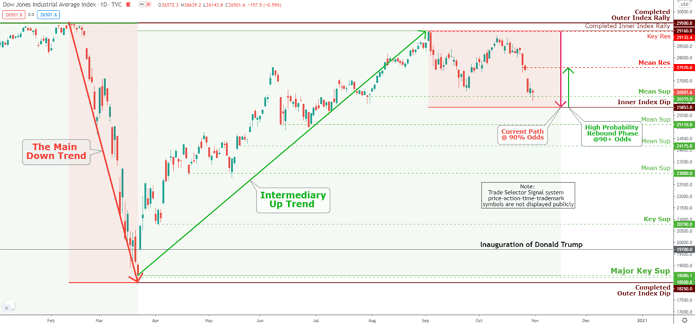Weekly Market Review & Analysis For October 26, 2020

The major market indices sank more than 5% this week, as it was overcome with growth worries, risk, and negative price action momentum. The DJI Average was the lowest performer with a 6.5% drop, and the small-cap Russell 2000 with -6.2%, S&P 500 with -5.6%, and Nasdaq Composite with -5.5% followed firmly behind.
There was no shortage of negative news. Earnings reactions continued to be disappointing, stimulus discussions fell through, the United States set a new record for daily COVID-19 cases, Pfizer drug maker postponed the release of its Phase 3 virus vaccine trial results that were anticipated this week, and the market movement of new home sales numbers surprisingly declined in September - act surprised here.
The negative headlines fed de-risking battles in front of the American presidential election on Tuesday, November 3, which was destined to be another adverse headwind for the markets due to its unpredictable outcome. The industrials and information technology sectors with -6.5% were the most vulnerable sectors, while the utilities sector declined the least with a 3.5% drop.
The stock market briefly stopped hemorrhaging on Thursday, as the mega-capitalized equities rallied in front of their anticipated earnings reports. Unluckily, Amazon, Apple, and Facebook sold off, notwithstanding beating expectations, while Alphabet had a favorable reaction. Microsoft, which announced their earnings earlier in the week, fell noticeably also.

Click the Image to Enlarge
Technical Analysis and Outlook: Since Dow Jones Industrial Average intermediary trend of the 'Inauguration of Donald Trump' line, we have completed the Outer Index rally $29,500 and developed a significant Key Sup marked at $29,132. The stocks will need to complete the Inner Index Dip $25,853 to launch a meaningful rally to Mean Res $27,570 and encounter major Key Res $29,132, and this will signify the challenge of the completed Inner/Outer Rallies.
Elsewhere
U.S. Treasuries market finished the week intermixed and very little changed. The Two-year yield declined one basis point to close at 0.15%, while the Ten-year yield rose two basis points to finish at 0.86%. The U.S. Dollar Index promoted 1.3% to settle at 94.05. West Texas Intermediate crude futures sank $4.18 or 10.5% to close at $35.70/bbl.
This week, Bitcoin breached the $13,000 mark. The price shoots up on the 27th and 28th of October, reaching a weekly high of $13,863; however, that didn’t last long. The price went downhill and got a second chance on Thursday. Slowly but surely, the price made the new high of $14,099 as I write this report.
The week in the cryptocurrencies felt like a roller-coaster, but Bitcoin’s prices are still 3% higher than the beginning of the week! The interest in Bitcoin is growing; you can see that in everything. For example, Michael Saylor, founder of MicroStrategy, personally holds 17,732 Bitcoins. That’s more than $230 million!
Gold and Silver bounced back as we conclude the week on election concerns and an unexpected reappearance of its safe-haven asset appeal. BTW, with Gold and Silver, you have to choose your price point for an upside breakout and buy into that for the reason that it will preserve you a lot of investment capital somewhat rather than just paddling in a stagnant market like we are having at this time.
Overseas market
Every significant market in Europe and Asia was down under the water. As new lockdowns were established in Italy, Germany, Spain, and France, ECB (European Central Bank) President Christine Lagarde stated that the economy was succumbing much faster than anticipated. More monetary incentives would be coming by the end of the year.
The European Stoxx 600 index fell 5.4% this week; the German DAX30 index was fragile. Software producer SAP SE, which factors 10% of the index, declined a whopping 20% after lowering its revenue outlook because of the influence of coronavirus it has on its business.
The Asian-Pacific stocks did better than those in North America and Eurozone. In the land of the rising sun (Japan) was the best-performing matured market, as industrial production and employment numbers were much better than forecasted.